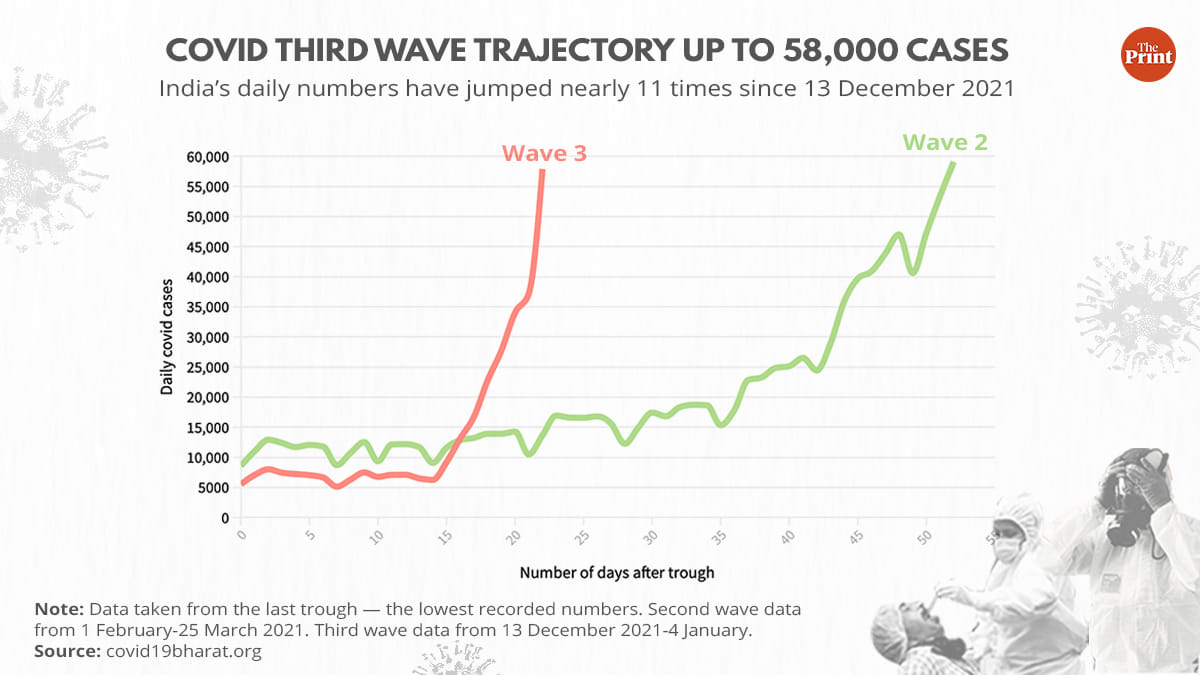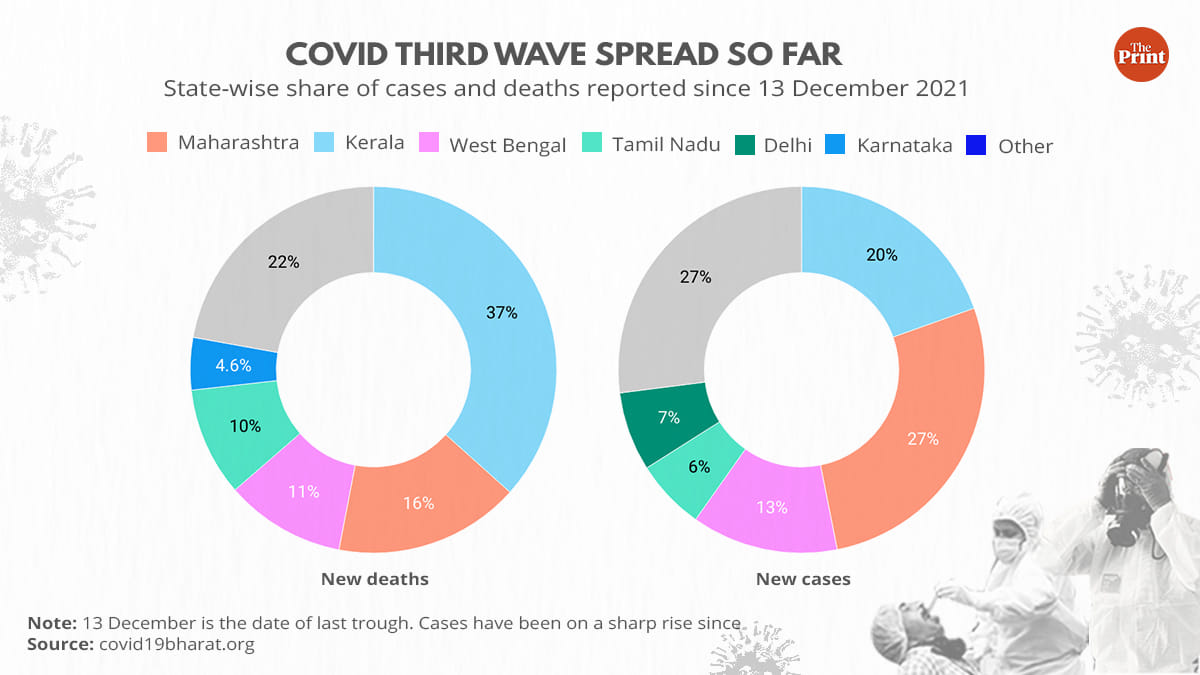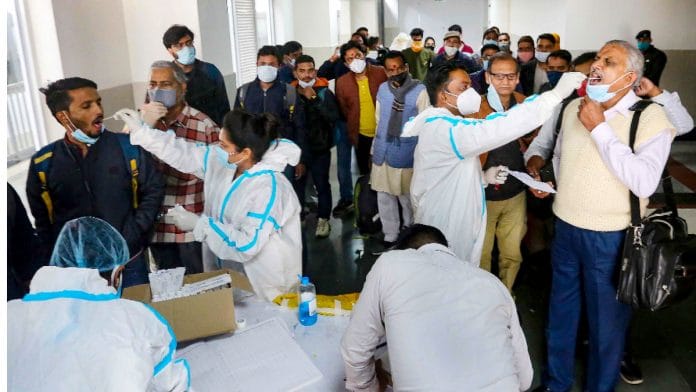New Delhi: Covid-19 infections have again exploded across India, barely 23 days after the country touched the trough post the second wave in April-May 2021. On Wednesday, India reported 58,097 fresh cases in 24 hours, up 55 per cent from a day earlier and nearly six times the figure from a week ago.
ThePrint’s analysis of Covid numbers sourced from covid19bharat.org, a crowd sourcing platform compiling data from all states and union territories’ health bulletins, shows that the current growth in cases is at least over twice as fast as compared to the previous wave.
Taking 13 December as the beginning of this surge in infections, in just 23 days, India’s daily Covid numbers have jumped over 10 times — from 5,541 to 58,097 on 4 January.

Before April 2021, when India witnessed a sudden spike in its Covid numbers in what came to be known as the second wave, the transition from the trough — the lowest recorded numbers — to above 58,000 cases happened in about 53 days (8,579 cases on 1 February to 59,085 on 25 March 2021).
Also read: Fear of another migrant exodus why Delhi hasn’t imposed stricter restrictions as Covid surges
Fewer deaths as compared to 2nd wave
So far, in the first 23 days of the current surge, India has recorded more than 3.14 lakh cases. In the first 23 days of the second wave, India had reported about 2.8 lakh cases.
However, despite higher growth in cases this time, India has recorded fewer deaths. The official count shows that since 13 December, there have been 6,662 Covid deaths. But this includes 4,979 backdated deaths in Kerala, which means deaths that occurred before but have been added to the tally now.
In October last year, the Kerala health ministry decided to reconcile the Covid death figures that had not been updated before the system went online on 18 June 2021. As a result, the state has added more than 3,779 deaths. Moreover, the state has added 14,330 deaths based in a retrospective manner — counting in anyone who died within 30 days of testing positive for Covid, following the Supreme Court’s orders on issuing simplified guidelines. These deaths have gradually been added to the state’s tally since 22 October 2021.
Discounting these backlogs, India has recorded about 1,683 Covid deaths since the beginning of the current surge. In the first 23 days of the second wave, 2,200 deaths, roughly 24 per cent more than the current figure, had been reported.
Kerala’s Covid death figures continue to be a cause for worry. Even discounting the backlog, the state has recorded 691 deaths in the last three weeks. This is over twice as much as Maharashtra (309).
Of India’s total deaths in this period, Kerala accounted for about 41 per cent, followed by Maharashtra (18 per cent), West Bengal (12 per cent, 200 deaths) and Tamil Nadu (11 per cent, 172 deaths).
Also read: Delhi could have 40,000-1 lakh Covid cases daily in few weeks, disaster management meeting told
Which areas are worst-hit?
Data shows that just three states reported 60 per cent of all the cases detected since 13 December.

Maharashtra reported 86,024 cases (27 per cent), followed by Kerala (61,575, 20 per cent) and West Bengal (40,692, 13 per cent). If the numbers of Delhi (21,953 cases, 7 per cent) and Tamil Nadu (19,541 cases, 6 per cent) are clubbed too, then these four states and the national capital are responsible for 73 per cent of the total cases in the current surge.
District-level data suggests that as of now, Covid is mostly spreading in the big cities. Nearly one-third of India’s total cases recorded in the past three weeks have come from state capitals.
Since 13 December, Mumbai has reported about 41,000 (13 per cent) cases and its adjacent Thane district has recorded 13,847 cases (4 per cent). Delhi has recorded 21,953 cases (7 per cent) followed by Kolkata’s 19,743 cases (6 per cent) and Thiruvananthapuram’s 11,675 cases (4 per cent).
Warnings so far
Studies have shown that the current Omicron-led surge is milder than the previous ones, in terms of symptoms and hospitalisation requirement. However, the Indian government has acknowledged that the rapid rise in numbers could still pose a threat to the existing healthcare infrastructure.
In a press briefing last month, V.K. Paul, NITI Aayog member who heads at least four Covid panels in India, had warned that the country could face up to 14 lakh cases a day if it doesn’t get cautious. Paul’s warning was based on the scale of Covid infections in some European countries that were hit despite high vaccination rates.
It is worth noting the fact that in the previous wave, at most, the reported number of cases had peaked at a little over 4 lakh daily cases. Hence, 13-14 lakh cases a day, even if they cause 50-60 per cent fewer fatalities, could prove to be a daunting challenge.
(Edited by Amit Upadhyaya)
Also read: How winter session of legislature, political weddings turned Covid ‘superspreaders’ in Mumbai






